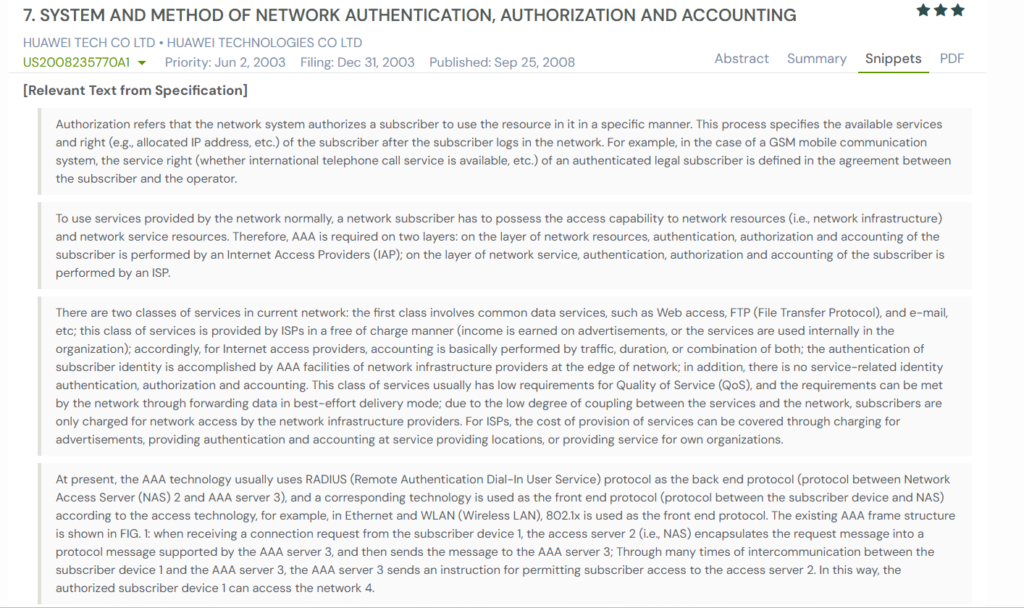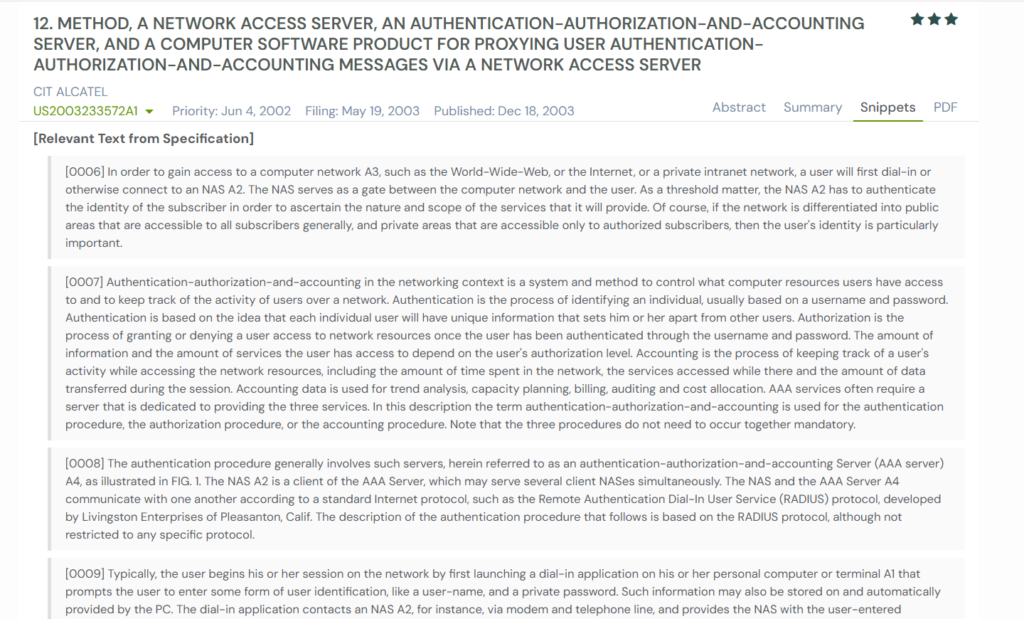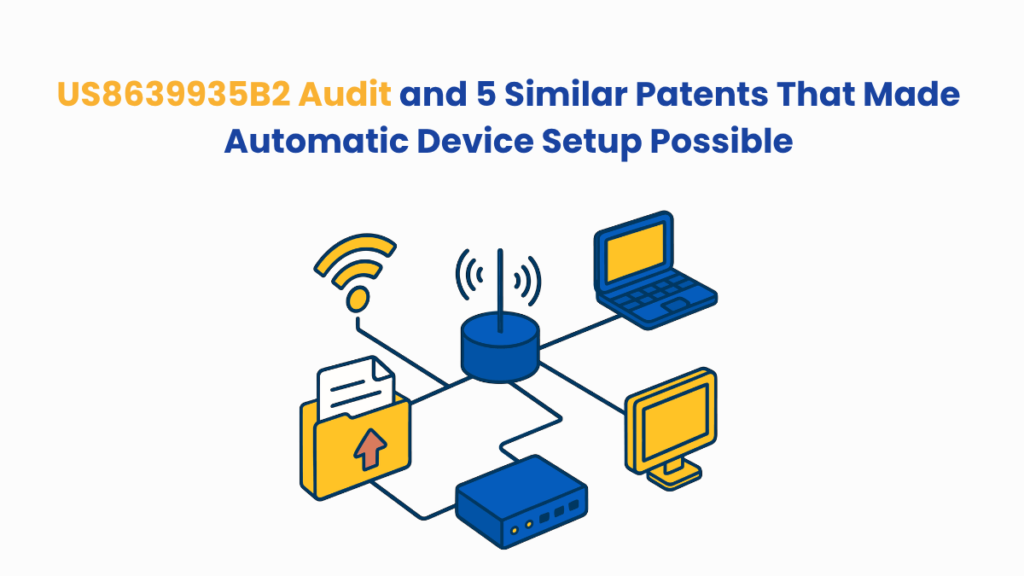Ever noticed how your new phone connects to the network within seconds of turning it on? No SIM setup, no tech support, just instant activation
That invisible ease is what US8639935B2 made possible.
Filed by Headwater Research LLC, the patent covers a smart way for devices to automatically link, verify credentials, and activate themselves over wireless networks. It turned what used to be a complex provisioning process into a seamless, encrypted handshake between device and server.
The idea is so foundational that it’s now being asserted in lawsuits against major carriers like AT&T and T-Mobile, proving how deeply it’s embedded in modern connectivity.
To see how this innovation evolved and where similar ideas emerged, we turned to the Global Patent Search tool.
What Makes US8639935B2 The Backbone of Modern Wireless Connectivity
When you buy a new phone or smart device, you expect it to connect and start working almost instantly. US8639935B2 explains how that’s possible.
The patent describes a secure system that lets devices activate themselves automatically. Instead of going through manual setup or customer support, the device talks directly to a central server. The server sends an encrypted message with all the setup details like user credentials, network settings, or permissions, and the device uses that information to complete activation on its own.
Here are the key technical features of US8639935B2
- Automatic provisioning: Devices can connect, identify themselves, and receive configuration settings automatically. This removes the need for manual setup or technician involvement.
- Encrypted and credential-based setup: Every message between the device and the server is encrypted for security. Each device uses its own credential to ensure only authorized systems can activate.
- Server-managed control: A central server oversees how each device connects, activates, and updates. It ensures every setup command is accurate and sent to the right device.
- Scalable multi-device management: The system is built to handle large fleets of devices at once. Whether it is phones, routers, or IoT sensors, each device follows the same seamless activation process.
- Reliable and seamless experience: By automating configuration and security checks, the patent minimizes human error. It delivers faster, smoother activations that users barely notice happening.
Together, these features built the foundation for how devices today connect, authenticate, and activate without human help. Let’s see how this idea evolved and what other innovations emerged around it.
Recommend Read: You can read a similar deep-dive on wireless network control in our Wireless Tech Patent US9031537B2 and Related Inventions article, which explores how mobile devices switch seamlessly between network types.
Early Innovations That Shaped Automated Device Activation
Every major innovation in network automation builds on earlier ideas. Before US8639935B2 redefined how devices activate and connect on their own, companies were already working on smarter ways to manage communication, policy control, and charging across networks.
To see where this patent fits in that evolution, we explored earlier innovations using the Global Patent Search tool.

Let’s look at a few key patents that share a similar vision.
1. US2008189760A1
Filed by Cisco Technology Inc. in February 2007, the patent introduced a smarter way to manage how applications are charged for network usage. It described a setup where a policy server sits between users, applications, and the network to handle billing automatically.
Instead of requiring every app to manage its own charging logic, the policy server identifies which application is running, applies the right charging rules, and manages resources on its behalf. This made billing more dynamic and accurate while improving overall network efficiency.
The concept overlaps with US8639935B2, which also focuses on automation between devices and servers. Cisco’s automated charging went further by automating activation and provisioning itself.
The Bigger Picture
The patent showed how networks could think for themselves. By letting servers make smart, application-aware decisions, Cisco helped pave the way for modern systems where devices connect, configure, and operate without any manual effort.
2. US2008235770A1
Filed by Huawei Technologies Co. Ltd. in December 2003, this patent focused on improving how users are authenticated and authorized within a network. It aimed to simplify how people and devices access different services using one unified identity, instead of logging in separately for each.
The system introduced a smarter AAA (Authentication, Authorization, and Accounting) model. It allowed a single login to grant access to multiple network services, managed both by Internet Access Providers and Internet Service Providers.
This design made it easier for users to connect, while giving service providers better control over who could use which resources.

The idea aligns closely with US8639935B2, which also focuses on secure, automated connections between devices and networks. Huawei’s invention streamlined user authentication; US8639935B2 took it a step further by automating the entire provisioning process.
The Bigger Picture
Huawei’s patent marked a turning point toward unified digital identities and smarter network access.
It laid the foundation for seamless user and device experiences, where one secure handshake could unlock multiple services, something that US8639935B2 later expanded into the world of automated device activation.
3. US2013010802A1
Filed in September 2012, the patent by inventors Amir Ansari and team describes a smarter way to manage multiple digital services at the user’s end through a multi-services gateway.
The idea was to create a clear line or demarcation between what the service provider controls and what the user manages on their devices.
In this system, most of the heavy network functions that once lived on the provider’s side were moved into the user’s gateway device. This allowed things like media delivery, access control, and data backup to run locally, but still be monitored remotely by the provider.
Essentially, the gateway acted as a middle ground, keeping user devices flexible while giving providers oversight on performance and policy enforcement.
This closely ties to US8639935B2, which also focuses on secure, automated coordination between devices and central systems. While the gateway patent managed service logic between the user and provider, US8639935B2 focused on how devices themselves could be provisioned and activated automatically under similar control principles. Both aimed to make complex network setups feel effortless for the end user.
The Bigger Picture
The patent captured the shift toward intelligent edge management, where user devices became powerful enough to host and manage their own network functions. It bridged the gap between local control and remote supervision, an idea that echoes strongly in US8639935B2’s vision of seamless, automated device activation.
4. US2003233572A1
Filed by Alcatel SA in May 2003, the patent focused on improving how user authentication works in complex network setups. It introduced a method that allowed a Network Access Server (NAS) to act as an intelligent gateway, forwarding authentication and authorization requests to the right AAA server without slowing down access.
In simple terms, it made the sign-in process smarter. Instead of every network running its own isolated authentication system, Alcatel’s design lets multiple networks coordinate user verification through a chain of connected AAA servers. This made it possible for users to move across different service domains like corporate networks or ISPs without needing to log in again each time.

The patent shares common ground with US8639935B2 in how it handles identity and authorization at scale.
While Alcatel’s focus was on making network access seamless and secure for users, US8639935B2 applied similar principles to device provisioning.
Both ensured that authentication, configuration, and access happened behind the scenes, keeping the user experience simple.
The Bigger Picture
The invention helped shape the foundation for unified login experiences across distributed networks. It was an early move toward the kind of interconnected systems we now see in IoT and cloud environments.
In these systems, devices and users are authenticated once and stay trusted across multiple platforms, just as envisioned in US8639935B2.
5. US2008304500A1
Filed by ECI Telecom Ltd. in November 2006, the patent introduced a new kind of home gateway architecture that acted as a bridge between local home devices and external networks like the internet. The goal was to simplify how devices inside a home could communicate with outside servers and access services such as streaming, calling, or video conferencing.
Unlike earlier setups that required multiple systems for configuration and connection, this invention introduced a Service Application Programming Interface Layer (SAPI Layer). It served as a translator between home devices and external services, managing everything from bandwidth and authentication to billing. This made it possible for devices inside the home network to use advanced telecom and internet services without changing software or hardware.
The overlap with US8639935B2 lies in the idea of automated provisioning and communication between devices and network systems. While ECI Telecom focused on seamless service delivery within home gateways, US8639935B2 extended the automation to the provisioning process itself.
The Bigger Picture
The patent reflected a major step toward smarter, self-managing networks. By embedding intelligence into gateway devices, it helped set the stage for today’s connected homes and IoT ecosystem. It provided a way where every device can activate, communicate, and deliver services effortlessly.
Comparison Overview: How US8639935B2 Connects with 5 Similar Patents
Each of these five patents explored different ways to simplify communication, authentication, and service management across networks.
When viewed together, they trace the journey from manual network setups to the seamless, automated device activation enabled by US8639935B2. Here’s a quick snapshot of these patents:
| Patent | Core Focus | Technical Overlap with US8639935B2 | The Broader Picture |
| US2008189760A1 (Cisco Technology Inc.) | Introduced application-specific online charging using a policy server to handle billing and resource management automatically | Both patents use centralized, policy-driven control to manage network interactions securely between devices and servers | Marked the shift toward intelligent, application-aware networks that could make real-time decisions without manual setup |
| US2008235770A1 (Huawei Technologies Co. Ltd.) | Focused on unified AAA (Authentication, Authorization, and Accounting) systems allowing one identity for multiple services | Shares the concept of automated authentication and resource authorization across devices and services | Helped move networks toward single-sign-on and unified identity management, key to modern automated provisioning |
| US2013010802A1 (Ansari et al.) | Proposed a multi-service gateway for managing applications at the user’s end while giving providers remote control | Aligns with how US8639935B2 connects devices to central systems for secure provisioning and monitoring | Showed how user-side intelligence and provider-side oversight could coexist for seamless service delivery |
| US2003233572A1 (Alcatel CIT) | Enabled NAS devices to proxy authentication requests through multiple AAA servers for smoother access control | Shares the theme of network automation and secure coordination between access servers and control systems | Paved the way for federated access systems and distributed authentication frameworks used in global networks |
| US2008304500A1 (ECI Telecom Ltd.) | Developed a home gateway architecture that acted as a bridge between home devices and external networks | Both focus on automated device communication and network integration without human configuration | Anticipated the connected home model and IoT-style automation where gateways handle provisioning and service delivery |
Connecting the Dots with Global Patent Search
When a patent like US8639935B2 comes into focus, it rarely exists in isolation. Behind every leap in automated device activation lies a network of earlier innovations. Each exploring different ways to make devices connect, authenticate, and communicate more intelligently.
That is where the Global Patent Search tool proves invaluable. It helps uncover how related patents, such as Cisco’s policy-based charging or Huawei’s unified AAA systems, fit into the broader story of network automation.
Here is how GPS helps reveal those links:
- Start with intent, not just numbers: You can search using the patent itself US8639935B2 or phrases like automated provisioning system or secure device activation. GPS reads both the technical details and the meaning behind them to surface truly relevant results.
- Zero in on meaningful overlaps: Instead of reading entire specifications, GPS highlights the exact sections from patents and NPL where similar ideas appear, such as credential management, encrypted communication, or policy control.
- Spot the patterns that matter: Many network automation patents reuse core ideas like secure authentication, credential exchange, and server-managed provisioning in new ways. GPS helps you identify these shared patterns instantly, revealing how one breakthrough leads to another.
- Make research actionable: Whether you are assessing licensing opportunities, analyzing R&D directions, or studying potential overlaps, GPS transforms dense technical data into clear, structured insight.
For anyone exploring automation in device provisioning or network management, GPS is more than a search tool. It is a window into how the connected world has been built, one innovation at a time.
Try the tool and find how easily those connections come together!
Disclaimer: The information provided in this article is for informational purposes only and should not be considered legal advice. The related patent references mentioned are preliminary results from the Global Patent Search tool and do not guarantee legal significance. For a comprehensive related patent analysis, we recommend conducting a detailed search using GPS or consulting a patent attorney.




